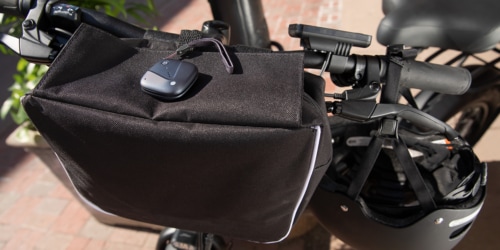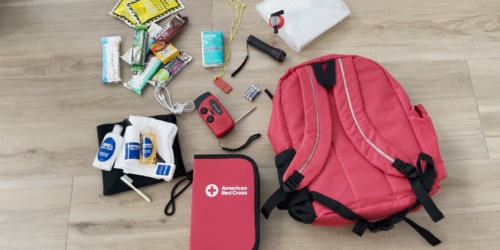In our haste to break free from our pandemic routines, we might find that life is picking up at an overwhelming pace. One product of all of this change is that it’s a little easier to misplace, well, our products. In fact, a survey conducted by the Bluetooth tracking company Pixie found that Americans spend an average of 2.5 days out of each calendar year searching for lost items.
You may have forgotten what it’s like to get up, get ready and have somewhere to go, but let us remind you how easy it is to misplace something you cherish. You’re suddenly back in the morning rush with other commuters, frantically trying to make a crowded train. Before you know it, you realize this is your stop and you hastily make it out the door, only to realize you just left your new travel case with your laptop inside it under your seat. Looks like your belongings are enjoying the rest of the ride without you.
Some of the items you carry with you daily — like that designer travel bag you finally splurged on or the DSLR camera you always wanted — aren’t cheap to replace. As the saying goes, time is money, and replacing these items can have a serious impact on our wallets as well.
If these items are so important, then why exactly do we keep misplacing them? A common reason is that the item was simply lost in a moment of absentmindedness. Psychologists have a phrase for this: “If you don’t encode, you can’t retrieve.” If you’re not consciously thinking about where you’re placing that item in the midst of the madness, your brain has no information stored about the item’s whereabouts when it suddenly isn’t in your possession. Other factors, such as our stress levels and overall mental health, can also play a role in our items disappearing.
From age-old psychology tricks and mindful habits to a bit of digital device help, here are a few actionable tips for when your precious possessions are accidentally out of sight and out of mind … but thankfully, may not be gone forever.
1. Picture the scene.
“Retracing your steps” after losing an item can actually be a really useful approach, and the concept of context-dependent memory gives a bit of insight as to why. With context-dependent memory, our memory is the strongest when we mentally or physically place ourselves back in the environment in which the item was lost. Try this: next time you walk out of a room and forget what you were doing, paint a mental picture of yourself just a minute or two prior to walking out of that room. This reconstruction of events can help to trigger your memories of why you left the room, and this can also be an important step in rediscovering a misplaced item. In addition to visualizing the scene, try to clear your mind of any anxious or distracting thoughts relating to the missing item. This can help you begin your search in a calmed state.
2. Keep yourself in check with written and digital reminders.
If you regularly run into the issue of losing track of specific items, digital reminders might be for you. Regardless of the type of phone that you use, a variety of great productivity apps are out there that can give you that extra reminder that you need to double check your wallet for your debit card or ID before heading out of the house. Most calendar apps such as Google Calendar and Outlook have remind features that can help you create good habits around organizing your items. There are also useful apps like Todoist that specialize in creating useful reminders and daily lists on your smartphone.
In that same vein are your classic physical reminders — notebooks, sticky notes and old-fashioned to-do lists that can decorate your home or workplace with helpful hints and pointers. There’s no shame in jotting down reminders for yourself and putting them around the mirror or the door so they’ll always be there during your busiest times of the day. Studies have shown that information can be recalled a bit easier when written, so sticky notes might be the best way to go for those who prefer pen and paper.
3. Try a Bluetooth tracker for your smaller items.
For smaller items like your phone, wallet and keys, Bluetooth tracking can provide a little bit of tech help. On those busy mornings at home when your phone unfortunately disappears and you’re late for an important meeting, Bluetooth trackers are great. They’re designed for those times that you lose an item within close proximity. So instead of wasting those precious minutes searching your living room for your phone (or keys or wallet), you can just pull up an app and save yourself some stress.
4. But also make sure to protect those truly precious possessions (and pets).
When it comes to big-ticket items, like that new guitar you forgot in the back of a cab, you’ll need something with a little more to offer. T-Mobile’s SyncUP TRACKER uses a combination of GPS technology as well as the Un-carrier’s reliable nationwide network to track an item at anytime from anywhere. Those devices previously mentioned that rely on Bluetooth technology often have limitations in terms of tracking range or other capabilities. For your high-value items like luggage, bicycles and even pets, T-Mobile’s SyncUP TRACKER has features like virtual boundaries that connect to the tracker, which will alert you if that tracked possession (or pooch!) leaves a designated area.
It’s reassuring to know that you can always have eyes on your important items — even when you’ve taken your eye off the ball of minding them — and that your camping gear, or musical instruments or expensive electronics will be only an app view away.
More info about the SyncUP TRACKER, the app available for both iOS and Android, as well as T-Mobile’s reliable LTE network and GPS technology, can be found here.
Remember: Just because you lost an item doesn’t mean that you should lose hope! With a few changes to your routine and even some tech upgrades, you’ll find it much easier to cope during those forgetful moments.





